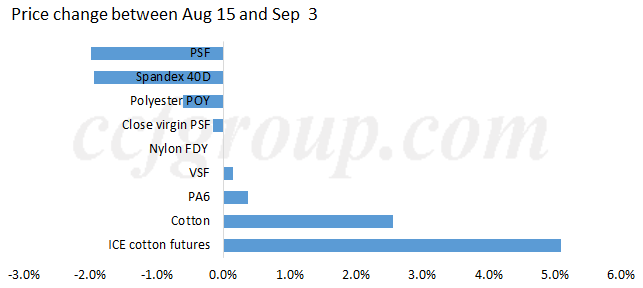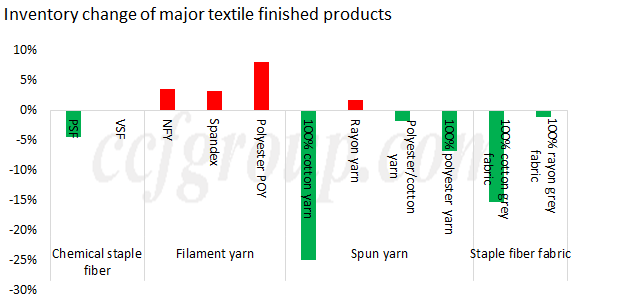Price, inventory, and operating rate changes of major textile products
Is this year's traditional peak season in September showing up across various textile products, despite the fading of peak season characteristics in recent years due to factors like e-commerce, supply chains, and market trends?

From a pricing perspective, cotton seems to be performing relatively well, with prices rising, which could be related to its previous downward trend. In contrast, synthetic fibers have generally declined recently due to falling crude oil prices. Overall, since the second half of August, prices for viscose staple fiber, nylon, and cotton have risen, while those for polyester staple fiber, spandex, polyester filament yarn, and recycled fibers have been in a downward trend. How are the key indicators, like inventory changes, which the market focuses on, performing?

As of September 3, aside from the increase in finished goods inventory at major filament factories compared to mid-August, inventories of most other major products have declined to varying degrees, especially for cotton yarn and pure cotton grey fabric. However, the declines in finished goods inventories for other products have been relatively limited. Regarding the decline in finished goods inventory at cotton yarn factories, is this due to downstream orders being fulfilled, or is it a result of inventory transfer? Our investigation reveals that both factors are at play, with neither side having a significantly stronger influence. Since mid-April of this year, cotton prices have been fluctuating downward, leading to cautious restocking in the raw material and trading segments of the cotton supply chain. However, in the second half of August, especially in late August, as cotton prices rebounded and seasonal demand orders increased, downstream weaving mills and traders increased their purchasing volumes, which in turn contributed to the reduction in yarn factories' finished goods inventory. Therefore, the inventory decline is the result of combined factors.

Regarding the operating rate of major textile products, from the second half of August to the present, the operating rate of most products have increased, with only spandex showing a decline, while nylon remained stable. Overall, the operating rate increases for spun yarn and staple fiber fabric have been more noticeable, which is partly related to the previously low operating rates. Although expectations for this year's peak season are generally low, based on the performance of various products since the second half of August, there are some signs that orders are increasing, though the degree of increase varies across products. Whether this trend will continue remains to be seen, but initial estimates suggest that orders will continue to increase gradually, albeit without major surprises.
- Top keywords
- Cotton Price
- Cotton Futures Price
- Cotton Futures
- CZCE
- PTA Futures Price
- Chemical Fiber
- Polyester Prices
- Wool price
- PTA Futures
- Shengze Silk
- China
- Yarn Price
- price
- China Textile City
- Fibre Price
- Benzene Price
- Cotton
- Index
- Cotton Index
- PTA
- fabric price
- NYMEX
- Top 10
- textile industry
- Spot Cotton
- Cotton Yarn
- Polyester Price
- Futures
- PTA Price
- cotton yarn price

